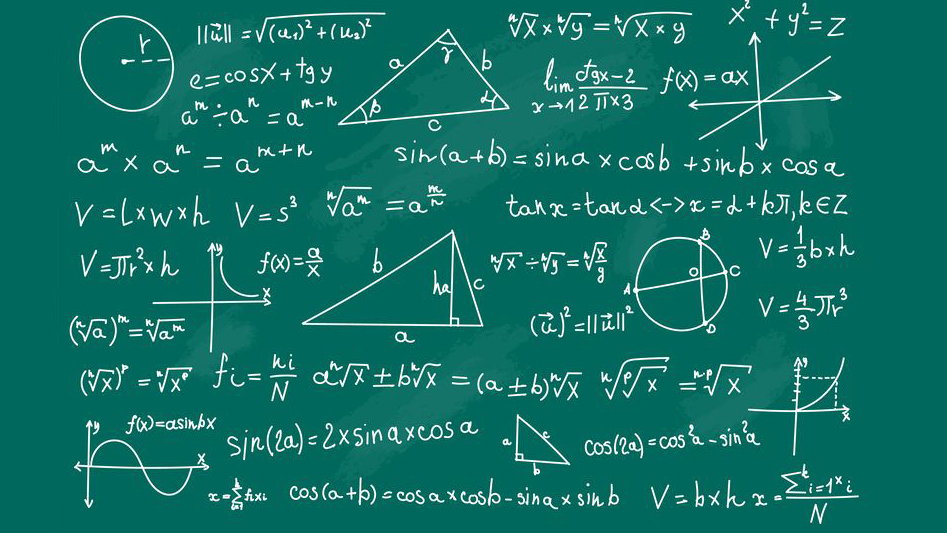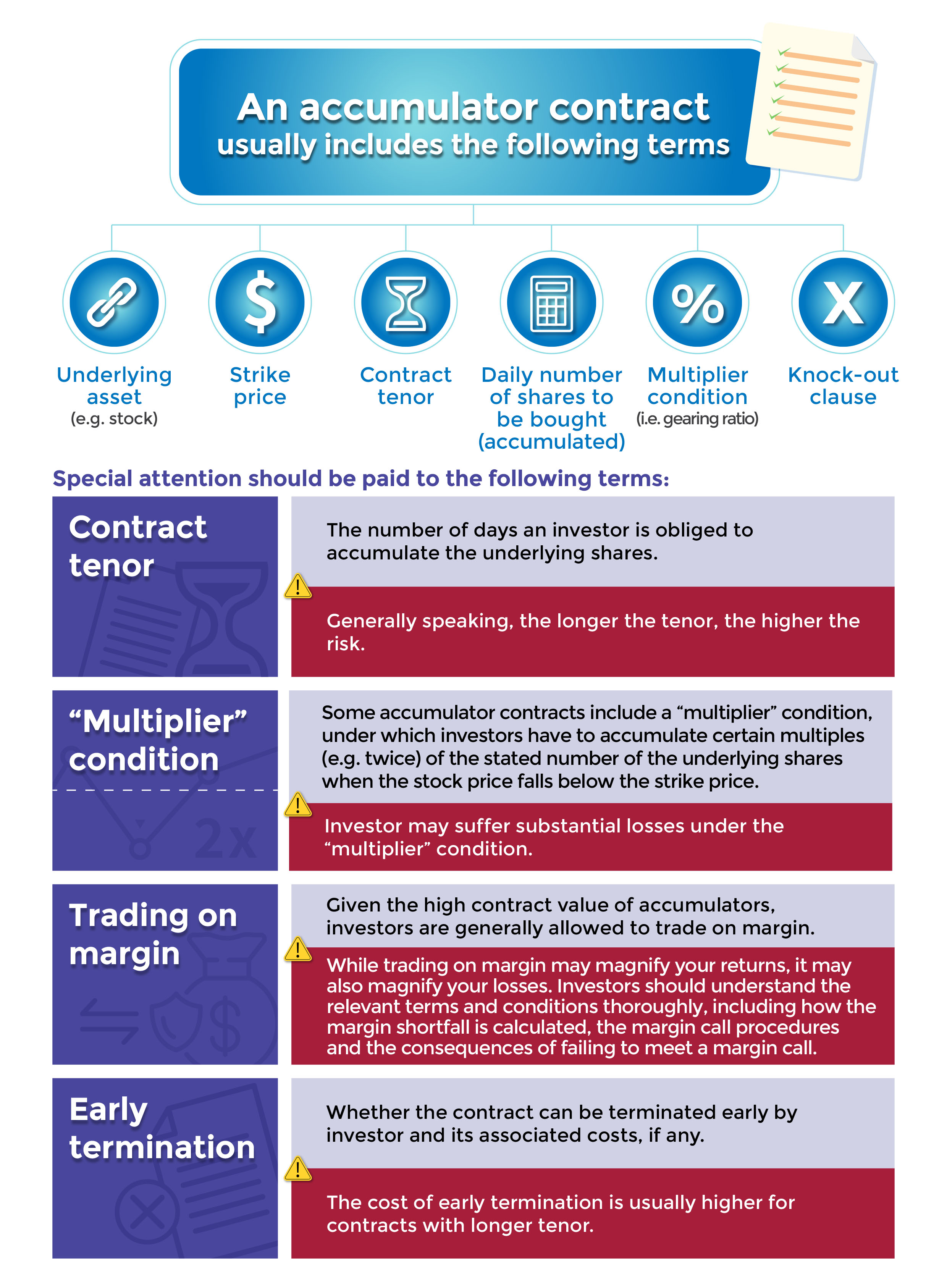To safeguard our rights and interests, it is important to always read the terms and conditions thoroughly before signing any contracts. And the same goes for investing in an accumulator, which is essentially an investment contract with many complicated provisions.
Read the contract thoroughly
Over-the-counter (OTC) accumulators, which are not traded on exchange, do not have standardised terms. Both the buy side and sell side negotiate the contract terms, such as contract tenor, daily number of shares to be bought (accumulated), and the strike and knock-out prices, etc. Some accumulator contracts may even come with special terms such as a “multiplier” condition.
Decumulator
Apart from accumulators, there is another instrument called “decumulator”, which is the reverse of an accumulator. Simply put, a decumulator contract requires an investor to sell a fixed number of underlying shares at a pre-determined price (i.e. the strike price which is usually higher than the market price on the contract date) every day. The risks and returns of decumulators are also different from those of accumulators. As decumulators are structured to capture the downside of the underlying share price, investors will have to bear the upside risk of the price, which could be theoretically unlimited.
Both accumulators and decumulators are complex structured products. Investors should fully understand the structure, operation and risks of these products and ensure that they have sufficient net worth to assume the risks and bear the potential losses before investing.
Example of an accumulator transaction
| Underlying asset | Stock A |
| Tenor | 6 months |
| Shares accumulated per day | 3,000 shares |
| Accumulation days | 20 trading days per month x 6 months = 120 days |
| Strike price | HKD10 |
| Knock-out price | HKD13 |
| Initial price of Stock A | HKD12 |
| Multiplier/ Gearing ratio | 2 |
| Initial margin ratio | 30% |
| Number of shares accumulated: |
If strike price =< market price of Stock A:3,000 shares per day If strike price > market price of Stock A: 6,000 shares per day (=3,000 shares x gearing ratio of 2) If market price of Stock A >= knock-out price: |
| Maximum total number of shares accumulated: | 720,000 shares (= 3,000 shares per day x gearing ratio of 2 x 20 trading days per month x 6 months) |
| Maximum notional amount | HKD7,200,000 (= 720,000 shares x HKD10) |
Margin requirement
-
The investor is required to meet the margin requirement when the accumulator contract remains effective.
Margin requirement = initial margin requirement + mark-to-market loss
Initial margin requirement
-
When entering into an accumulator contract, the investor should deposit the initial margin to the counterparty.
Initial margin requirement = notional amount* x initial margin ratio
*Notional amount = strike price x number of shares per day x gearing ratio (if applicable) x number of remaining days in the contract
-
The counterparty has the discretion to increase the margin requirement at any time during the contract period in response to market condition.
-
For the example above, the initial margin requirement on Day 1 of the contract would be HKD2,160,000.
= Notional amount x initial margin ratio
= [ Strike price HKD10 x 3,000 shares per day x gearing ratio of 2 x 120 remaining days ] x initial margin ratio of 30%
= HKD7,200,000 x 30%
= HKD2,160,000
Mark-to-market loss
-
During the contract period, if the market price of the underlying stock drops, the investor will have to bear the estimated mark-to-market losses for the remaining period of the contract. If the accumulator contract includes a “multiplier” condition, the mark-to-market loss may also be magnified.
Mark-to-market loss = (strike price – market price) x number of shares per day x gearing ratio (if applicable) x number of remaining days in the contract
-
Investors should note that the counterparty may use option pricing model in valuing the mark-to-market value of the accumulator contract. The model may consider different factors, such as spot price, strike price, time-to-maturity, volatilities, etc. As a result, the mark-to-market loss in a real life situation may be different from the simplified formula above.
Margin call and margin shortfall
-
The market value of the investor’s collateral pledged with the counterparty should be sufficient to cover his margin requirement. If the collateral value falls below a pre-set level (e.g. 95%) of the margin requirement, the counterparty will issue margin calls to the investor to cover the margin shortfall. Investors should be mindful that the counterparty has the discretion to determine the pre-set level.
Margin shortfall = margin requirement – collateral value
Example of margin call and margin shortfall
- For the example above, assuming the stock price of Stock A fell to HKD8 on Day 2 of the contract.
-
The initial margin requirement on Day 2 would be HKD2,142,000.
= Strike price (HKD10) x 3,000 shares per day x gearing ratio of 2 x 119 remaining days x initial margin ratio of 30%
= HKD2,142,000
-
However, there would be a mark-to-market loss of HKD1,428,000 due to the drop in the stock price of Stock A.
= [Strike price (HKD10) – market price (HKD8)] x 3,000 shares per day x gearing ratio of 2 x 119 remaining days
= HKD1,428,000
-
Therefore, the margin requirement of the investor would become HKD3,570,000 (= HKD2,142,000 + HKD1,428,000).
-
Assuming the market value of collateral deposited by the investor with the counterparty is only HKD3,000,000, which is below 95% of the margin requirement, the counterparty will issue a margin call to the investor to cover the margin shortfall of HKD570,000 (= HKD3,570,000 – HKD3,000,000).
-
When there is a margin call, the investor is required to deposit funds or assets to the counterparty within a specified time. Otherwise, the investor will be forced to close out the contract and bear the costs and losses, which may be significant. Moreover, the counterparty has the right to realise part of or all of the investor’s collateral according to the terms of the relevant collateral documents to satisfy the investor’s liabilities.
Worst-case scenario
For the example above, assuming the followings:
- Market price of Stock A has not reached the knock-out price during the contract period
- Market price of Stock A stayed below the strike price throughout the contract period
- The investor held all the accumulated shares of Stock A till the end of the contract
- Market price of Stock A dropped to zero at the end of the contract
The loss incurred by the investor equals to the maximum notional amount of the contract:
= 3,000 shares per day x gearing ratio of 2 x 20 trading days per month x 6 months x strike price (HKD10)
=HKD7,200,000
|
The above loss suffered by the investor is far more than the initial margin at Day 1 (i.e. HKD2,160,000). |
Note: the above analysis is a simplified version for illustration purpose only. Investors should read all the terms and conditions provided by their counterparty carefully before entering into an accumulator contract.







